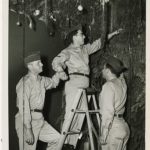Sukkot in the NJWB Records
by Rachel Rudman, M.A., Reference Services Research Intern, Center for Jewish History
This post is part of the Holiday History Series. To view all posts in the series, click here.
Above image: Decorating the Sukkah at Lowry Air Force Base, Denver, Colorado. Text on back of photograph: (l-r): Lt. Robert Goldberg, Brooklyn, N.Y.; Airman Maynard Schlager, Boston, Mass.; Chaplain Albert J. Leeman, Brooklyn, N.Y. October 1952. NJWBR. American Jewish Historical Society Collections.
As I discussed in my previous posts on Rosh Hashanah and Yom Kippur, Jewish holidays, along with their respective rituals and practices, are rooted in history and serve to facilitate individual connection to the collective Jewish past.
Sukkot, or the “feast of tabernacles,” calls for the building of temporary dwellings called “sukkot” (booths) in order to remind us of the precarious housing of the Israelites during their 40 years in the desert following the Exodus from Egypt. While remembering the experience of the Israelites in Egypt is of primary importance, congregational leaders desire to connect Sukkot to current events in order to make the holiday more relevant and meaningful to their community. Many examples of this can be found in the records of the National Jewish Welfare Board (NJWB), located in the American Jewish Historical Society collection at the Center for Jewish History.
The first example comes from a synagogue bulletin in October 1939. Just as Hitler began to reveal his answer to the “Jewish question,” one New York synagogue explained that the Sukkah represented the constant struggle of the Jewish people for freedom and existence. It describes the Sukkah as a perennial token of the survival of the Jewish people and their triumph in the face of oppression. The bulletin calls for the community to support and cling to the frail Sukkah, for it serves as the rock of the salvation during this terrible time for the Jewish people. By explaining the Sukkah as a symbol of survival during the Holocaust, the author of this bulletin addresses the current concerns of his community and increases the meaning of the holiday of Sukkot. (Call Number I-337, Subgroup 1, Series C, Subseries 4, Box 173, Folder 16. Click here for the finding aid.)
Another example of connecting Sukkot to current events can be seen in a holiday bulletin from the Jewish Community Center in Detroit in October 1944, a point at which Hitler had already carried out much destruction. After associating Sukkot with the Jewish people’s quest for freedom, this bulletin explains that the Sukkah, as a temporary shelter, is a reminder that life is transitory. The Sukkah serves as a reminder that millions of Jews in Europe have had no peace, rest or permanent shelter since the beginning of the war. The Sukkah, as a vulnerable and temporary shelter, also represents exposure to the elements and the hope of an end to war. (Call Number I-337, Subgroup 1, Series C, Subseries 4, Box 173, Folder 17. Click here for the finding aid.)
In attempt to keep Jewish holidays relevant to their community, leaders have often connected holiday rituals and symbols to current concerns of the Jewish people. These Sukkot bulletins during the Holocaust years are just two examples of many ways communities fused Jewish collective memory with contemporary Jewish struggles.

